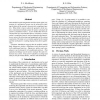Free Online Productivity Tools
i2Speak
i2Symbol
i2OCR
iTex2Img
iWeb2Print
iWeb2Shot
i2Type
iPdf2Split
iPdf2Merge
i2Bopomofo
i2Arabic
i2Style
i2Image
i2PDF
iLatex2Rtf
Sci2ools
ICRA
2000
IEEE
2000
IEEE
An Eigenscrew Analysis of Mechanism Compliance
Determination of the magnitudes and directions of the constraints of a mechanical system can be achieved by finding the basis of the system’s characteristic compliance matrix. When little is known about the geometry of the system, conventional methods cannot be used to calculate the system’s compliance matrix. A new method has been developed that uses experimental data to calculate a passive system’s compliance matrix, and an eigenvalue decomposition to extract the directions and magnitudes of the system constraints. The data were wrenches applied to the system and the mechanism’s resulting displacement from equilibrium. Computer simulations suggest that the method reliably finds eigenscrew pitches, compliances and directions for well-conditioned matrices. Eigenscrew pitches and compliances can be found for ill-conditioned matrices. This analytical technique can be used to evaluate the static behaviour of a system. It may prove valuable as a design and analysis tool for biom...
Compliance Matrix | ICRA 2000 | Robotics | System’s Characteristic Compliance | System’s Compliance Matrix |
| Added | 31 Jul 2010 |
| Updated | 31 Jul 2010 |
| Type | Conference |
| Year | 2000 |
| Where | ICRA |
| Authors | P. L. McAllister, R. E. Ellis |
Comments (0)

